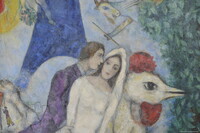| dc.coverage.spatial | Site: Centre Georges Pompidou (Paris, Île-de-France, France) AM 1988-67 | en_US |
| dc.coverage.temporal | 1938-1939 (creation) | en_US |
| dc.creator | Chagall, Marc | en_US |
| dc.date | 1938-1939 | en_US |
| dc.date.accessioned | 2015-01-05T21:40:44Z | |
| dc.date.available | 2015-01-05T21:40:44Z | |
| dc.date.issued | 1938-1939 | en_US |
| dc.identifier | 256046 | en_US |
| dc.identifier.other | archrefid: 3006 | en_US |
| dc.identifier.uri | http://hdl.handle.net/1721.3/171980 | |
| dc.description | Detail, central portion, couple and folkloric rooster; Chagall’s paintings of the 1920s, such as The Dream (1927), contain a strong element of fantasy already saluted as ‘surnaturel’ in 1914 by the poet Apollinaire. Chagall was invited to join the Surrealists, but he refused to do so, wary of their deliberate involvement with the subconscious mind. Nevertheless, a Surrealistic strain of dreamlike imagery can be said to run through all of his works, including Les mariés de la Tour Eiffel. His work is noted for its consistent use of folkloric imagery, evocations of Russian Jewish village life, and its sweetness of color. Chagall took French citizenship in 1937, but, with his wife Bella, he was forced to seek asylum in the USA in 1941 after he had been briefly imprisoned under the Vichy government in Marseille. Source: Grove Art Online; http://www.oxfordartonline.com/ (accessed 5/29/2014) | en_US |
| dc.format.medium | oil paint on linen canvas | en_US |
| dc.rights | © Scott Gilchrist, Archivision, Inc. | en_US |
| dc.subject | human figure | en_US |
| dc.subject | marriage | en_US |
| dc.subject | Eiffel Tower | en_US |
| dc.subject | Twentieth century | en_US |
| dc.title | Les mariés de la Tour Eiffel | en_US |
| dc.type | image | en_US |
| dc.rights.access | Licensed for educational and research use by the MIT community only | en_US |
| dc.identifier.vendorcode | 7A1-CM-LMTE-A02 | en_US |
| vra.culturalContext | French | en_US |
| vra.technique | oil painting (technique) | en_US |
| vra.worktype | painting (visual work) | en_US |
| dc.contributor.display | Marc Chagall (Belorussian painter, 1887-1985) | en_US |

